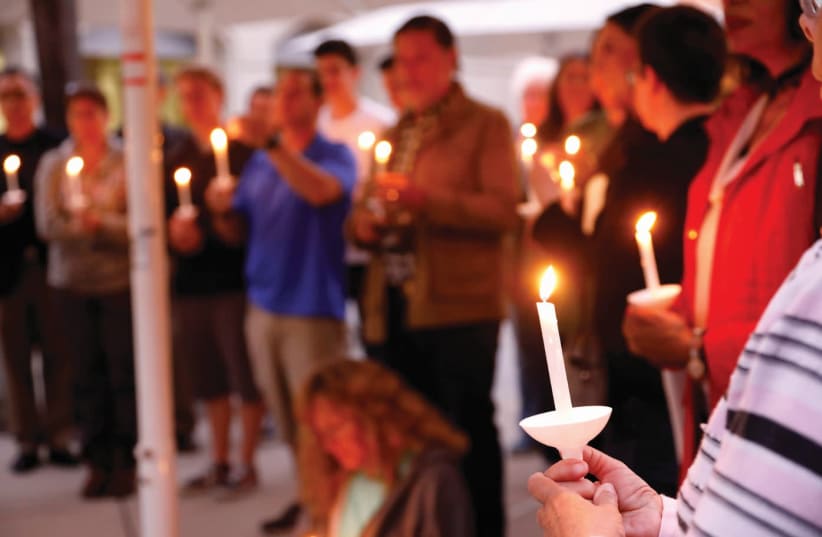Yet the question is not a new one. It was posed 20 years ago in an American Jewish Committee (AJC) newspaper ad in The New York Times, titled “Enough is Enough.” In June 1999, three synagogues in Sacramento, California, suffered arson attacks. In August, a sole shooter entered the Los Angeles Jewish Community Center, killed one person and left another five wounded, including children.
The 1999 summer of hate may have begun with Jews, but the perpetrators also targeted other minorities. Within days that July, an individual wounded nine Orthodox Jews in Chicago, killed an African-American and wounded another elsewhere in Illinois, and murdered an Asian-American in Indiana. Even the Los Angeles JCC attacker went on to murder a Filipino-American postal worker.
“Hate has become part of the American landscape,” the AJC ad declared in August 1999. It mentioned a wave of arson attacks on 145 black churches in 1995 and 1996. It also pointed out the 1995 bombing of the main federal government building in Oklahoma City, the worst incident of domestic terrorism at the time, which left 168 dead.
The ad posed two piercing questions. First, what will it take to acknowledge that domestic terrorism is tearing at the pluralistic fabric of American society? And second, would our elected officials respond differently if the murders were committed by foreign terrorists?
Following the September 11, 2001, attacks by al-Qaeda terrorists that killed nearly 3,000 on US soil, the American government shifted resources to focus on international terrorist organizations. And yet, hateful ideologies and access to weapons produced deadly attacks carried out by Americans again and again, with Jewish sites a consistent target. In 2009, an armed man entered the US Holocaust Memorial Museum and fatally shot a security guard. The 2014 attack on the Kansas City JCC and a nearby Jewish retirement home left three dead.
What linked the perpetrators of many assaults since 1999 was their adherence to white supremacist ideologies. Twenty years after the summer of hate, it has returned with new potency. After the deadliest attack on American Jews six months ago in Pittsburgh and now Poway, Jews again are wondering when and where the next assault may occur – and whether elected officials will make fighting hate a stepped-up national priority.
Hate was not solely a Jewish concern in 1999, and it still isn’t today. The repugnant ideology that inspired the murderous shooters in Pittsburgh and Poway also motivated the young arsonist who recently destroyed three historically black churches in Louisiana. And the accused Poway shooter had earlier attempted to burn down a mosque.
Yet the situation is even more dangerous now. Perpetrators of violent hate crimes abuse the everyday technology that is intended to bring us all closer together. Evildoers can learn from and support one another via the Internet and social media, and chillingly livestream their callous deeds.
DEVELOPING A comprehensive response and strategy is even more challenging, because America today is so deeply divided and polarized. Witness the constant verbal attacks emanating from Republicans and Democrats, each side asserting venomously that it is the true champion of Jewish interests and leading the fight against antisemitism.
It’s a dispiriting time. Overcoming inertia must be a priority. Combating antisemitism is one issue on which coming together to ensure the strength of democratic and pluralistic society should be a given.
Toward that end, a renewed effort already is under way, spearheaded by AJC, to encourage all members of the US House of Representatives to join the Bipartisan Task Force for Combating Antisemitism.
Created in 2015 with AJC input, the task force plays a critical role in coordinating congressional efforts, such as legislation and interparliamentary engagement, to combat antisemitism. While it has focused on addressing antisemitism around the world, pivoting to deal with rising antisemitism in the US is now necessary. According to the latest FBI annual report, Jews remain the primary target of religiously motivated hate crimes, with incidents in the US rising nearly 60% in 2017.
To date, 134 US representatives have joined the task force. Of course, congressional offices are approached quite regularly about joining one or another caucus on a multitude of causes and topics. But full membership in this task force would send a powerful message of bipartisan unity that the cancer of antisemitism from all its sources must be confronted head-on. It also would bolster any effort to develop a comprehensive strategic plan to eradicate enduring hatred.
This is a long-term endeavor. There’s no overnight solution. Pursued seriously and persistently, it will ultimately make American society stronger, and Jews as well as other vulnerable minorities feel safer and more secure.
The writer is the AJC’s director of media relations.
